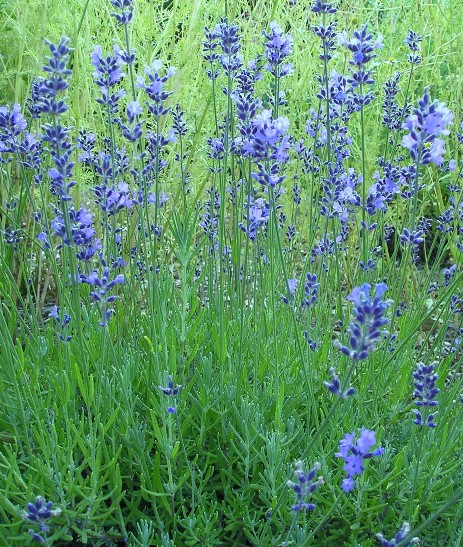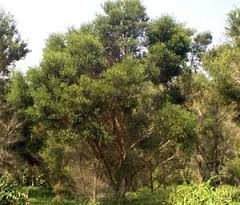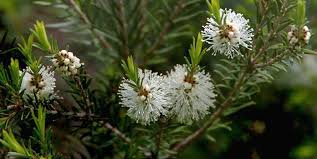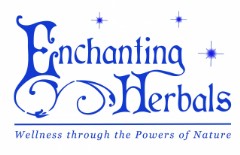Lavender and Tea Tree
Information > Essential Oils
Lavender & Tea Tree
...the two ESSENTIAL essential oils
Among essential oils, Lavender and Tea Tree stand out due to their exceptional qualities. They are incredibly versatile with a multitude of everyday uses.
Every home should be equipped with these oils due to their extraordinary usefulness in the first aid kit. You’ll find you have little need for other first aid remedies. They are the only two essential oils that can be used undiluted on the skin.
You know the expression “Don’t leave home without it”? Well that is absolutely the case with these oils. When away on vacation, they are always in my bag; during the summertime I carry a bottle of Lavender in my pocketbook. This truly is how essential they are.

Lavender
Botanical name : Lavandula officinalis, L. angustifolia
Description : A perennial shrub growing to 3 ft. with spikes of violet blue flowers extending above the foliage.
Distilled from : flowers
Origin : Native to France and the western Mediterranean, now cultivated worldwide.
Safety Data : non-toxic, non-irritating, non-sensitizing, can be used undiluted on skin, can be used safely on children, even infants.
Lavender known as “first aid in a bottle” is an invaluable first aid remedy. It is antiseptic, helps to heal burns, wounds, and sores. It relieves pain and inflammation from insect bites and stings.
Description : A perennial shrub growing to 3 ft. with spikes of violet blue flowers extending above the foliage.
Distilled from : flowers
Origin : Native to France and the western Mediterranean, now cultivated worldwide.
Safety Data : non-toxic, non-irritating, non-sensitizing, can be used undiluted on skin, can be used safely on children, even infants.
Lavender known as “first aid in a bottle” is an invaluable first aid remedy. It is antiseptic, helps to heal burns, wounds, and sores. It relieves pain and inflammation from insect bites and stings.
Key Actions
Analgesic, antiseptic, antibacterial, relieves muscle spasms, antidepressant, stimulates blood flow, sedative, anti-inflammatory.
Traditionally used for:
Skin care – sunburn, burns (all types including kitchen & radiation) insect bites, spider bites, head lice, cuts, dermatitis, eczema, insect repellent, psoriasis, scabies, inflammations, ringworm, dandruff, abscesses.
*Some sources say it can help treat the bites of black widow and funnel web spiders; also some snakes such as vipers and adders…at least to help you on your way to the hospital!
Muscular system – muscle aches and spasms, sprains, muscle and joint stiffness.
~Adding a few drops to a bath relieves muscle tension, toning the nervous system and promoting a restful sleep.
Nervous system – depression, headaches, migraines, insomnia, nervous tension and stress-related conditions, anxiety, fatigue, hypertension.
~ Headaches can be relieved by massaging a few drops into the temples.
Traditionally used for:
Skin care – sunburn, burns (all types including kitchen & radiation) insect bites, spider bites, head lice, cuts, dermatitis, eczema, insect repellent, psoriasis, scabies, inflammations, ringworm, dandruff, abscesses.
*Some sources say it can help treat the bites of black widow and funnel web spiders; also some snakes such as vipers and adders…at least to help you on your way to the hospital!
Muscular system – muscle aches and spasms, sprains, muscle and joint stiffness.
~Adding a few drops to a bath relieves muscle tension, toning the nervous system and promoting a restful sleep.
Nervous system – depression, headaches, migraines, insomnia, nervous tension and stress-related conditions, anxiety, fatigue, hypertension.
~ Headaches can be relieved by massaging a few drops into the temples.
l
Tea Tree
Botanical name : Melaleuca alternifolia
Description : An evergreen reaching 22 ft. with layers of papery bark, pointed leaves and white flower spikes.
Distilled from : leaves and twigs
Origin : Native to Australia
Safety Data : non-toxic, non-irritating, possible sensitization in some individuals, can be used undiluted on skin.
Tea Tree has a long history of use by the native people of Australia. Extensive research has shown its unique quality of being active against all three infectious organisms: bacteria, fungi and viruses. It is also a powerful immuno-stimulant enabling the body to “step up” to fight off threatening organisms. It is strongly antiseptic yet very well tolerated by our skin.
Description : An evergreen reaching 22 ft. with layers of papery bark, pointed leaves and white flower spikes.
Distilled from : leaves and twigs
Origin : Native to Australia
Safety Data : non-toxic, non-irritating, possible sensitization in some individuals, can be used undiluted on skin.
Tea Tree has a long history of use by the native people of Australia. Extensive research has shown its unique quality of being active against all three infectious organisms: bacteria, fungi and viruses. It is also a powerful immuno-stimulant enabling the body to “step up” to fight off threatening organisms. It is strongly antiseptic yet very well tolerated by our skin.

Key Actions
Antiseptic, antibacterial, antifungal, antiviral, immuno-stimulant, expectorant, analgesic, anti-inflammatory.
Traditionally used for:
Skin Care – acne, warts, athlete’s foot, ringworm; infected burns, scrapes & wounds; ear & body piercings, insect bites& stings, cold sores, herpes, rashes, tick repellent, dandruff. Relieves pain and inflammation of pimples, even the ones on our bottoms!
Genitourinary system – vaginitis, *cystitis, vaginal yeast infections.
*treatment under professional supervision
Respiratory system – asthma, sinusitis, bronchitis, sinus and nasal congestion.
~ To help relieve sinus/nasal congestion: apply 2-3 drops to a cotton ball and inhale through nostrils, exhale through mouth, continue for 5 minutes.
Repeat as needed.
Antiseptic, antibacterial, antifungal, antiviral, immuno-stimulant, expectorant, analgesic, anti-inflammatory.
Traditionally used for:
Skin Care – acne, warts, athlete’s foot, ringworm; infected burns, scrapes & wounds; ear & body piercings, insect bites& stings, cold sores, herpes, rashes, tick repellent, dandruff. Relieves pain and inflammation of pimples, even the ones on our bottoms!
Genitourinary system – vaginitis, *cystitis, vaginal yeast infections.
*treatment under professional supervision
Respiratory system – asthma, sinusitis, bronchitis, sinus and nasal congestion.
~ To help relieve sinus/nasal congestion: apply 2-3 drops to a cotton ball and inhale through nostrils, exhale through mouth, continue for 5 minutes.
Repeat as needed.

Sources:
Encyclopedia of Herbal Medicine, by Andrew Chevallier, FNIMH
Essential Aromatherapy, by Susan Worwood & Valerie Ann Worwood
The Encyclopedia of Essential Oils, by Julia Lawless
Aromatherapy for the Soul, by Valerie Ann Worwood
The Essential Oils Book, by Colleen K. Dodt

